Effects pedals provide guitarists with sonic options. Playing clean is great, but having several pedals at your disposal allows you to transform your tone when the right time arises. With so many quality pedals available, searching for the right one can be a frustrating task, especially as a lot of them have similar qualities.
In my opinion, phaser pedals should be a staple of every pedalboard. Their versatile nature, mind-bending potential, and dramatic swirls of psychedelic layers make them unique in the world of audio processing. The great thing about phase is that no matter what genre or style of guitar you play, it will blend in and breathe new life into your tone.
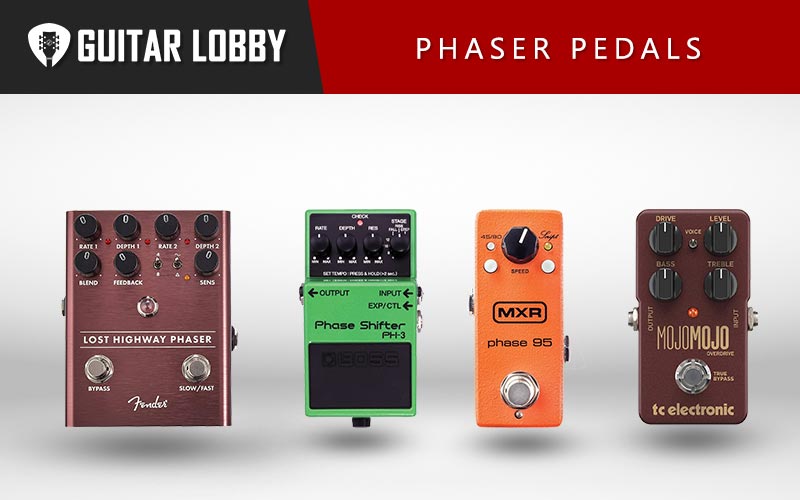
Not only are phase pedals useful for completely changing the sound of your instrument, but they can also be used to create ambient soundscapes, building tension on stage. Experimenting with a phase pedal is tones of fun, and once you’ve learned the theory behind the parameters you can embark on a journey of creating unique phased sounds to enhance your compositions and performances.
I’ll start this article by reviewing the best phaser pedals at each price point, but if you want to learn more about them before reading reviews, check out our phaser pedal information guide at the bottom of the page here.
| Name of Product | Image of Product | Description | Price Range | Full Review |
|---|---|---|---|---|
| 1. Fender Lost Highway (Best Overall) | 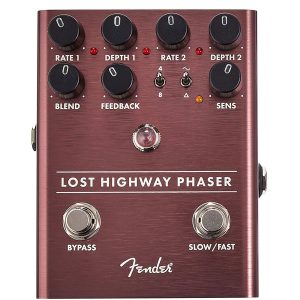 | Type: Analog Effects: Phase | $150 | Read Full Review Below |
| 2. Boss Phase Shifter PH-3 (Best Value) | 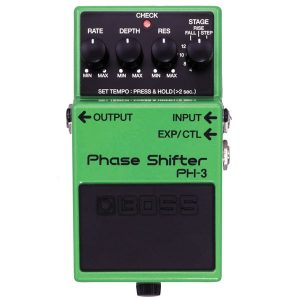 | Type: Digital Effects: Phase | $130 | Read Full Review Below |
| 3. MXR M290 Phase 95 (Best Under $100) | 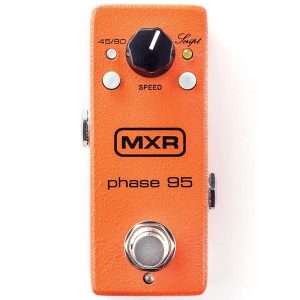 | Type: Digital Effects: Phaser | $100 | Read Full Review Below |
| 4. Stax Guitar Phaser Pedal (Best Under $50) | 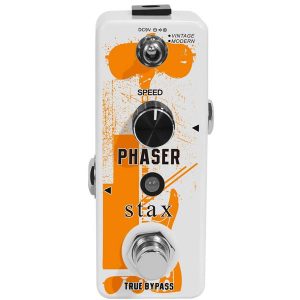 | Type: Analog Effects: Phaser | $35 | Read Full Review Below |
| 5. MXR M101 Phase 90 | 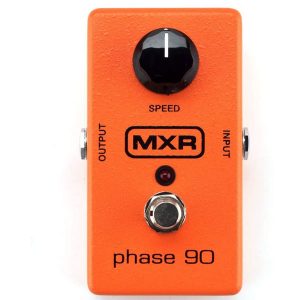 | Type: Analog Effects: Phase | $80 | Read Full Review Below |
| 6. SONICAKE 5th Dimension | 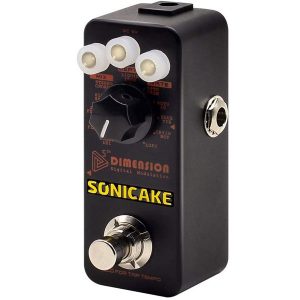 | Type: Digital Effects: Phaser, Flanger, etc | $60 | Read Full Review Below |
| 7. Walrus Audio Lillian | 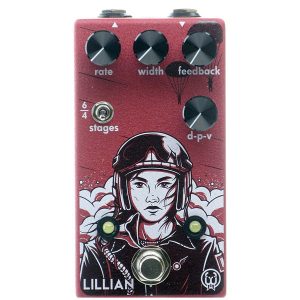 | Type: Digital Effects: Phaser | $200 | Read Full Review Below |
| 8. Donner Pearl Tremor | 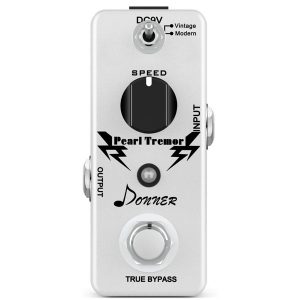 | Type: Digital Effects: Phaser | $30 | Read Full Review Below |
| 9. Valeton Multi-Effects | 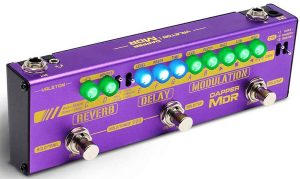 | Type: Digital Effects: Phase, Reverb, Modulation | $130 | Read Full Review Below |
| 10. NUX MOD Core Deluxe | 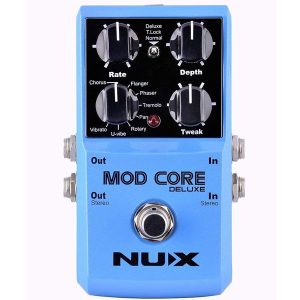 | Type: Digital Effects: Phaser, Chorus, Flange | $80 | Read Full Review Below |
| 11. BOSS MD-200 | 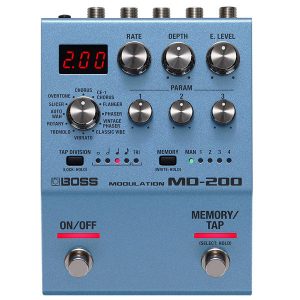 | Type: Digital Effects: Phase, Flange, Chorus, Auto Wah, Vibrato | $250 | Read Full Review Below |
| 12. Electro Harmonix Small Stone | 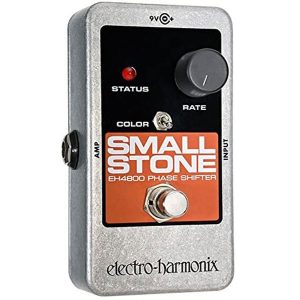 | Type: Analog Effects: Phase | $100 | Read Full Review Below |
| 13. Behringer VP1 Vintage Phaser | 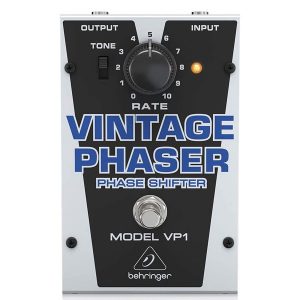 | Type: Digital Effects: Phaser | $60 | Read Full Review Below |
| 14. TC Electronix Helix Phaser | 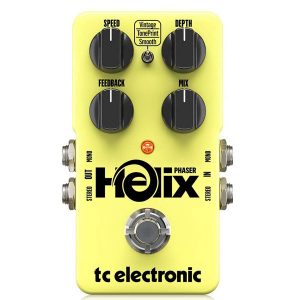 | Type: Digital Effects: Phaser | $130 | Read Full Review Below |
| 15. Keeley Dark Side | 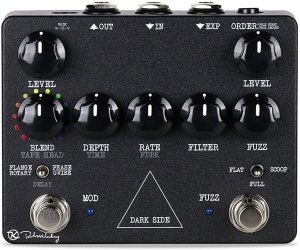 | Type: Digital Effects: Phase, Flange, Fuzz | $300 | Read Full Review Below |
| 16. MXR EVH90 | 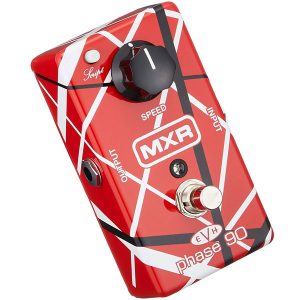 | Type: Digital Effects: Phase | $230 | Read Full Review Below |
| 17. JOYO R-09 Modulation Pedal | 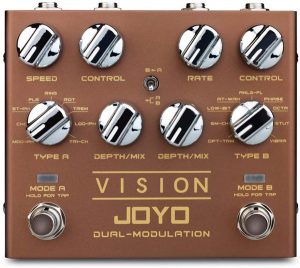 | Type: Digital Effects: Phaser, Chorus, Tremolo, Flange, | $90 | Read Full Review Below |
Here Are the Best Phaser Pedals
1. Fender Lost Highway (Best Overall)
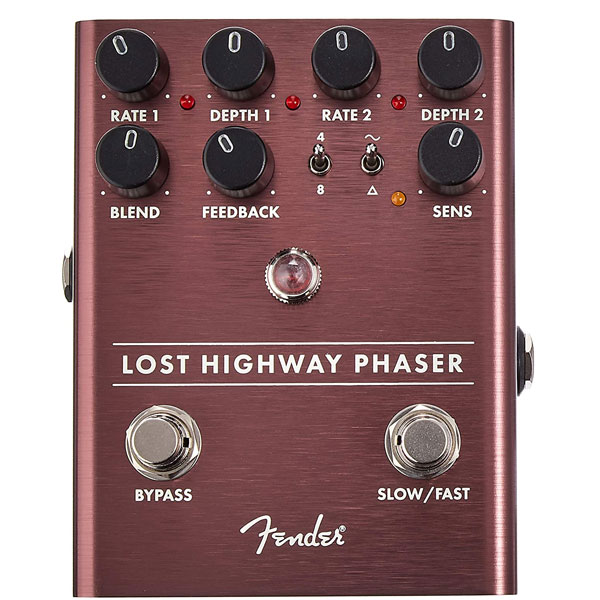
| Estimated Price | $150 |
| Type | Analog |
| Effects | Phase |
| Connectivity | 1 x 6.35mm Jack Input, 1 x Outputs |
| Power | 9 Volt |
My Review: Although Fender is best known for its range of exceptional guitars and basses, they also produce some top-end pedals. The Lost Highway is an analog phaser pedal that colors your instrument with unique textures and movements. With its instantly recognizable design, durable aluminum housing, and specifically designed circuitry, there’s no questioning the quality of the Lost Highway.
Fitted with speed control that can be adjusted with a footswitch, you can tweak the phasing speed of the pedal from slow and progressive to fast and chaotic. Each phasing speed has an individual rate and depth controls which provide a wide range of dimensionality. The pedal can turn your guitar tone from clean to sci-fi in an instant.
There’s also the useful inclusion of a wave switch. This gives you access to several sine and triangle waveforms that lend themselves to lead guitar, chord playing, or ambient textures. The 4 and 8 stage phasing capabilities controls the resonance of the pedal.
To complete this highly detailed phaser, the Lost Highway has a sensitivity control. When turned up, the modulation rate increases and responds to the velocity of your playing. There’s also a Fender amp jewel LED light that completes the audiovisual design of the pedal.
Who This is Best Suited for: The Fender Lost Highway phaser pedal is filled with hands-free controls and features, ranging from footswitch control to velocity-sensitive modulation. Therefore, I’d recommend it to guitarists who like to constantly change their sound during a set, and require a quick and convenient way to do so.
Bottom Line: This Fender phaser pedal is as detailed as they come. It’s built like a tank, has an array of controls that can be tweaked in real-time, and produces just about every phased tone you can imagine. It’s the type of pedal that you can spend hours exploring and discovering new tones to add to your arsenal.
2. Boss Phase Shifter PH-3 (Best Value)
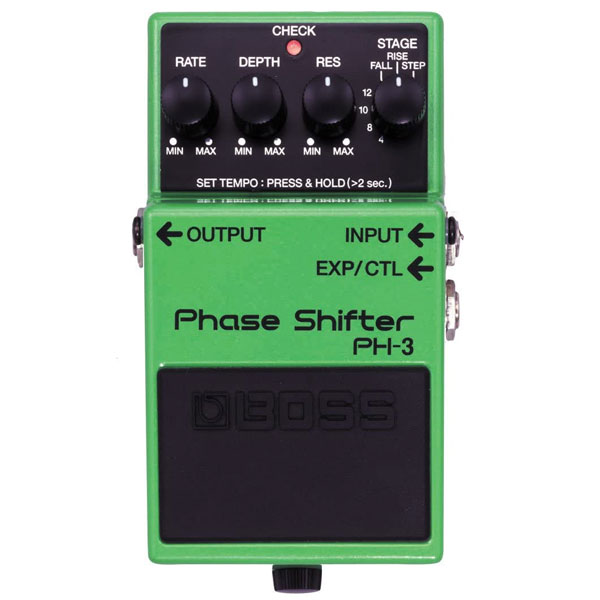
| Estimated Price | $130 |
| Type | Digital |
| Effects | Phase |
| Connectivity | 2 x 6.35mm Jack Input, 1 x Output |
| Power | 9 Volts DC |
My Review: If you’ve got some experience with effects pedals, you’ll likely have come across BOSS’ range of robust, reliable stompboxes. Bridging the gap between cheap entry-level pedals and advanced top-end offerings, BOSS pedals provide great value for money.
The PH-3 Phase Shifter pedal brings modern and vintage phase effects to your pedalboard. Housed in a conveniently sized stompbox are several multi-stage phasers, all fitted with adjustable parameters so that you can create unique swirling tones. The Rise and Fall modes give you access to many unidirectional sounds.
The Ph-3 Phase Shifter has Rate, Filter, and Tempo control onboard the pedal. These three parameters produce a broad range of effects, ranging from slow and steady to fast and aggressive phase. There’s also tap tempo functionality so you can synchronize the effect perfectly with the rhythm and tempo of a song. If you combine the PH-3 with a decent expression pedal, you can control most of its adjustable features hands-free on stage.
Who This is Best Suited for: If you want access to a wide range of phase-shifting options without having to navigate too many controls and parameters, the BOSS PH-3 is a great option. It’s not overly complex, but it still provides plenty of room for adjustment.
Bottom Line: The BOSS PH-3 Phase Shifter pedal is durable, compact, and detailed. The unique Rise and Fall modes give you access to some unorthodox phase tones, and the classic BOSS stompbox design is easy to operate. If you’re looking for the best phaser pedal for the money, this is one of my top suggestions.
3. MXR M290 Phase 95 (Best Under $100)
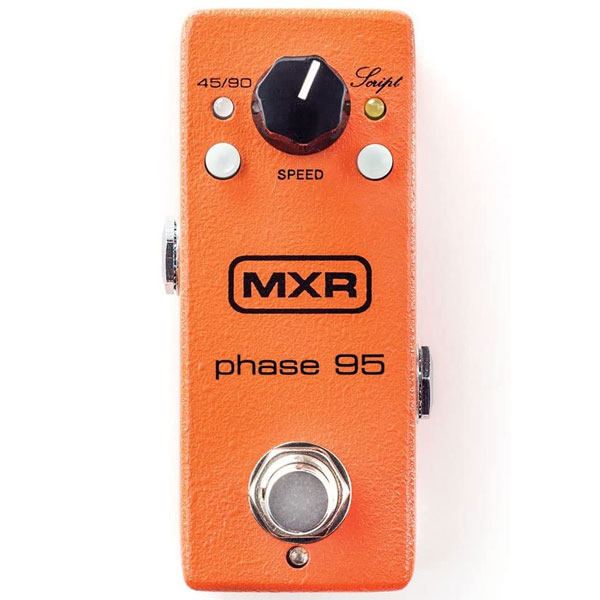
| Estimated Price | $100 |
| Type | Digital |
| Effects | Phaser |
| Connectivity | 1 x 6.35mm Jack Input, 1 x Output |
| Power | 9 Volts DC |
My Review: The MXR M290 Phase 95 is a mini phase-shifter pedal that’s design is based on two of the most popular phaser pedals to ever be manufactured. The original Phase 90 pedal was revered for its high quality, four-stage phaser, and was responsible for some of the most notable uses of the effect. Phase 45 that followed was a more simplistic, two-stage phaser that had a smoother output and lent itself to a wider range of musical genres. The M290 blends the best aspect of these two pedals.
There’s a 45/90 toggle switch that lets you select which one of the aforementioned phase pedals you want to access at any given time. The Script switch lets you dial in or boost the feedback of the effect, creating smooth tones when turned off and a more exaggerated phase when turned on.
Perhaps the best thing about the MXR M290 Mini Phase 95 is its compact and simple design. When you consider the range of phase-shifting tones this pedal is capable of producing, it’s impressive that MXR has been able to squeeze them into a housing that will slot into a small space on your pedalboard.
Who This is Best Suited for: If you value simplicity and quality, the MXR M290 Mini Phase 95 pedal is worth considering. It’s based on two of the best-loved phaser pedals in history, and yet is very simple to use and easy to familiarize yourself with.
Bottom Line: The MXR M290 is well worth the price. It has all of the capabilities of a much larger pedal and is filled with a surprising number of adjustable parameters. The switch design allows you to toggle between the two pedals that the M290 is modeled on.
Popular Related Article: 17 Overdrive Pedals That Are Too Good To Pass Up
4. Stax Guitar Phaser Pedal (Best Under $50)
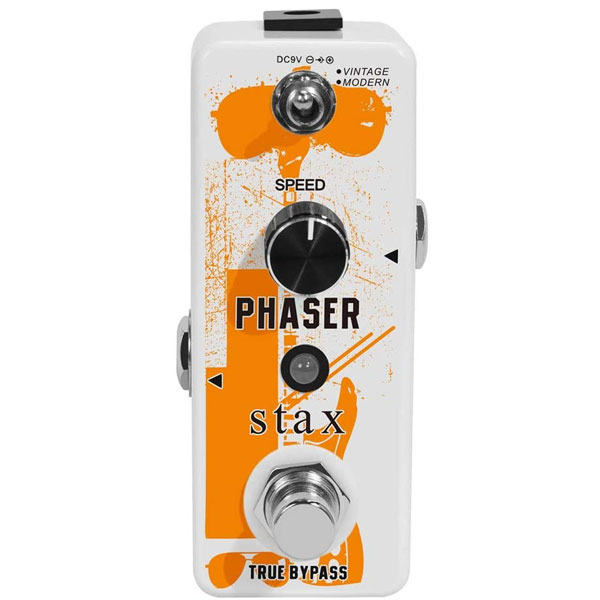
| Estimated Price | $35 |
| Type | Analog |
| Effects | Phaser |
| Connectivity | 1 x 6.35mm Jack Input, 1 x Output |
| Power | 9 Volts DC |
My Review: The Stax Guitar Phaser Pedal is a straightforward, affordable option that is pretty versatile for its small size. First of all, it has an interesting design and aesthetics. Speed control is the centerpiece of the pedal and is responsible for the rate at which the phaser operates.
Just above the Speed control is a toggle switch. This gives you access to a duo of working modes – Vintage and Modern. The vintage mode takes you back to the mid-seventies when phaser pedals were still in their infancy. This mode produces a psychedelic, airy phase that wouldn’t sound out of place on a Supertramp album.
The second switchable setting, Modern, offers more depth than the previously mentioned model. It sounds more sci-fi inspired, with rich overtones and mechanical rhythmic shifting. This pure-analog phaser pedal has a warm overall output and true bypass switching to keep your dry tone consistent even when the pedal isn’t in use. There’s also a smart LED indicator which comes in handy on a darkened stage.
Who This is Best Suited for: I’d strongly recommend the Stax Guitar Phaser pedal to any guitarist who wants a decent number of phase-shifting options without having to spend too much. Granted, it lacks the versatility of more expensive pedals, but it will still do a solid job.
Bottom Line: With two working modes, the Stax Guitar Phaser pedal provides you with a modern and vintage sounding phase with a warm analog feel. This minute pedal is minimalistic and easily operable and produces reliable effects. If you’re on a super tight budget, this is easily one of the best phaser pedals out there in this price range.
5. MXR M101 Phase 90
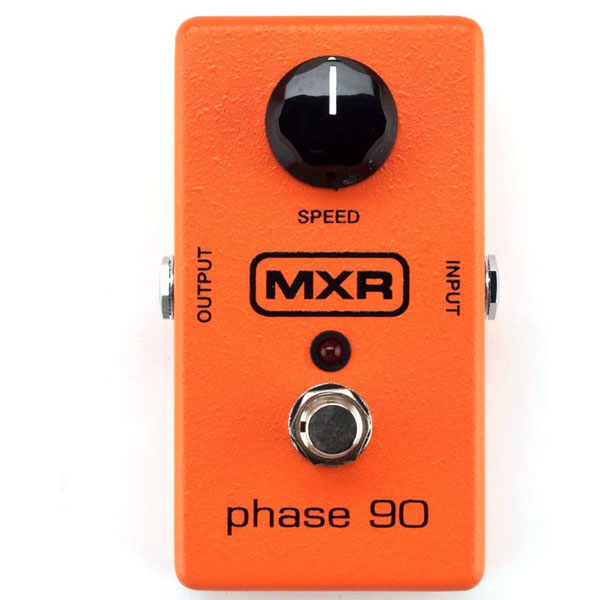
| Estimated Price | $80 |
| Type | Analog |
| Effects | Phase |
| Connectivity | 1 x 6.35mm Jack Input, 1 x Output |
| Power | 9 Volts DC |
My Review: The MXR M101 Phase 90 is the inspiration behind the M290 pedal that I previously reviewed in this article. Unlike the M290 that is based on two pedals, the Phase 90 is more geared towards smooth, rock-based phase effects and is used by some legendary musicians like Dave Grohl, Josh Homme, Eddie Van Halen, and Nancy Wilson. It’s equally suited to electric guitar, bass guitar, keyboards, or vocals too.
Phase 90 has a simple, single knob operation making it easy to use. Despite its seemingly limited number of controls, the pedal is still capable of producing a wide range of phase-shifting sounds, from subtle and slow to head-turning acceleration.
You can power the M101 Phase 90 either with a 9-volt power supply or a battery. The all-analog circuitry gives the pedal a vintage warmth that sounds authentic and not overly processed. By adjusting the speed/rate control, you can create some unique psychedelic phase tones. Interestingly, the Phase 90 also sounds great on vocals. It produces very little feedback and can completely transform a singer’s voice.
Who This is Best Suited for: The MXR M101 Phase 90 Pedal is a more basic version of the M290, but in some ways, it offers more versatility. If you like to experiment in the studio, I’d highly recommend the Phase 90 pedal as it can be used on basically any instrument or vocal track.
Bottom Line: This MXR pedal has been a staple of guitarist’s pedalboards since it was first manufactured. There’s a reason that the M101 Phase 90 is used by some of the best-known rock musicians around today because it offers an authentic-sounding analog phase and is extremely easy to use.
Popular Related Article: The Best Octave Pedals (All Price Ranges)
6. SONICAKE 5th Dimension
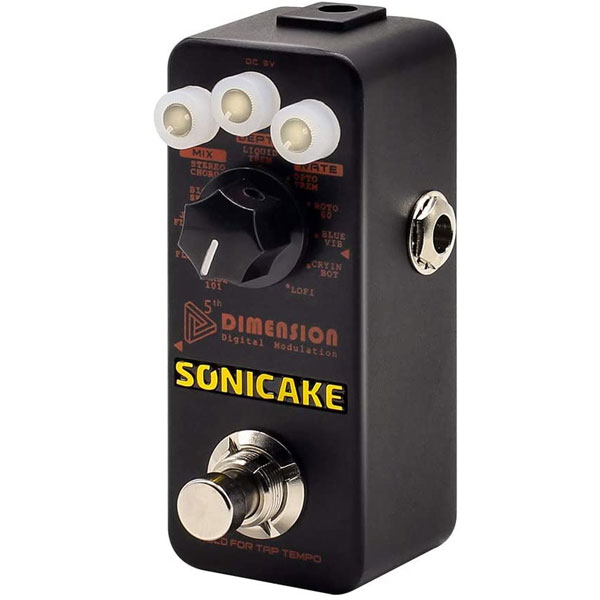
| Estimated Price | $60 |
| Type | Digital |
| Effects | Phaser, Flanger, Chorus, Tremolo, Vibrato, Auto-Wah |
| Connectivity | 1 x 6.35mm Jack Input, 2 x Output |
| Power | 9 Volts DC |
My Review: The 5th Dimension modulation pedal by Sonicake has a total of 11 digital effects that provoke new sonic possibilities from your guitar or bass. The pedal is laid out intuitively, with three rotary control knob on the top layer that affects the Mix, Depth, and Rate of the chosen effect.
Included with the 5th Dimension pedal are a range of processing options. There’s a phase, chorus, vibrato, flange, tremolo, univibe, auto-wah, and bitcrush. These effects can be toggled through by using the large knob in the center of the pedal, with a brief description of each setting. Another useful feature of the Sonicake pedal is the tap tempo function that lets you control the rate of the effects in real-time. This is great for locking in your guitar or bass track with the tempo and rhythm of a drummer or backing track.
True bypass switching maintains the integrity of your clean signal path, and the sleek design of the pedal won’t take up any unnecessary room on your board. This detailed multi-effects pedal is easy to use and adds 11 quality options to your guitar rig.
Who This is Best Suited for: The detailed 5th Dimensions pedal by Sonicake provides musicians with just about every modulation effect they could need, for a very affordable price. If you want to add multiple effects to your pedalboard along with a phaser, this might be the perfect solution.
Bottom Line: Multi-effects pedals provide a cheaper alternative to buying each pedal individually, but sometimes the overall quality can suffer as a result. With the 5th Dimension Digital Modulation Pedal, Sonicake has managed to produce a high standard of 11` processing options that all sound refined and will enhance your tone.
7. Walrus Audio Lillian
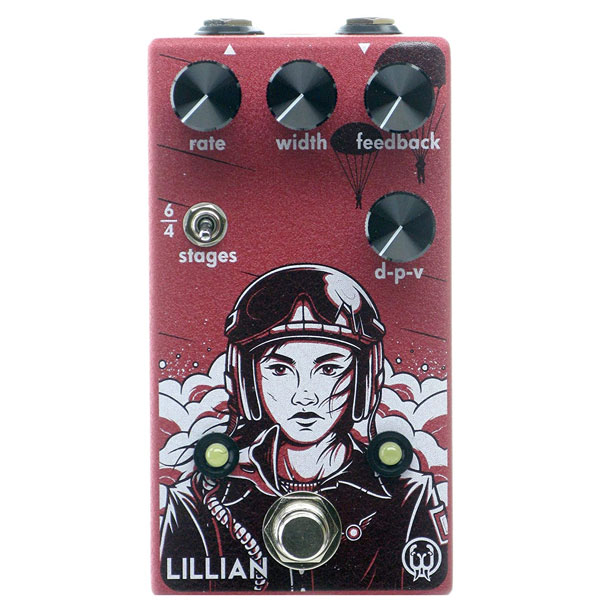
| Estimated Price | $200 |
| Type | Digital |
| Effects | Phaser |
| Connectivity | 1 x 6.35mm Jack Input, 1 x Output |
| Power | 9 Volts DC |
My Review: Walrus Audio’s range of top-quality pedals are instantly recognizable. With their unique, eccentric artwork and color schemes, they certainly stand out amongst the competition. The Lillian is an analog phaser pedal that provides you with two main phasing options. Firstly, you can select the 4-stage phaser which has a vintage feel and produces classic warm tones. Alternatively, you can select the 6-stage phaser for a more filtered and processed sound.
Where the Lillian excels is with its D-P-V (dry, phase, vibrate) control. This feature can be used to explore the whole soundscape of the pedal’s phase. You can move from smooth and vibrant phasers to frantic vibrato.
To complement Lillian’s premium tone, you also get high-quality true bypass switching that keeps it consistent when playing live. This pedal is the perfect option for producing a small range of refined phase tones.
Who This is Best Suited for: If you value quality over quantity, the Walrus Audio Lillian phaser effects pedal is worth considering. It is focused on producing only the best phase-shifting tones, and although it’s one of the more expensive options on this list, as soon as you hear it you can see why that is.
Bottom Line: The Lillian pedal by Walrus Audio is based around a 4-stage phaser and a 6-stage phaser. Both of these modes offer a range of high-quality processing effects, from vintage and warm to modern and aggressive. The pedal is easy to use and is built to absorb any damage it may be subjected to on the road.
Popular Related Article: Our 17 Favorite Reverb Pedals
8. Donner Pearl Tremor
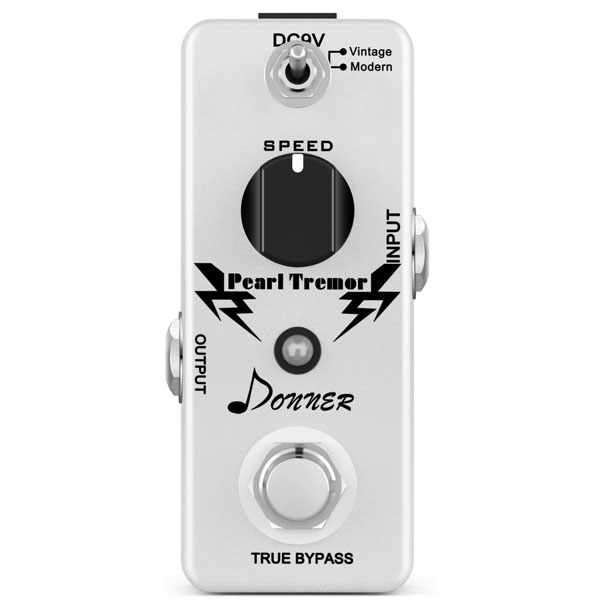
| Estimated Price | $30 |
| Type | Digital |
| Effects | Phaser |
| Connectivity | 1 x 6.35mm Jack Input, 2 x Output |
| Power | 9 Volts DC |
My Review: Donner is a fast-growing producer of entry-level effects pedals. Their Pear Tremor is a concise phaser pedal that uses pure analog circuitry to produce warm and versatile phase-shifting. With an all-aluminum chassis, the pedal is robust and durable. It features a switch at the top center, a knob control in the middle, and a footswitch at the bottom of the pedal.
The switch that is located at the top of the pedal allows you to toggle between two distinct settings – Modern and Vintage. The Modern selection adds a futuristic edge to the phaser, with aggressive overtones and pulsating rhythms. The Vintage mode is more subtle, warm, and understated. You can then adjust the speed and rate of your chosen phase mode by tweaking the large knob that is positioned in the center of the pedal.
There’s also the addition of a bright LED indicator to signify when the pedal is on or off, and true bypass switching to maintain the integrity of your clean tone when the pedal isn’t being used.
Who This is Best Suited for: If you’re on a tight budget, the Donner Pearl Tremor pedal is a good option. It’s not going to produce out-of-this-world phase-shifting effects, but the limited number it does produce all sound authentic. The minimalist layout may suit those who are lacking in experience with effects pedals.
Bottom Line: For around $30, the Donner Pearl Tremor is a great value for the money. It has two switchable modes – Vintage and Modern, which give you access to classic phase tones of years gone by or the more processed sounds of today.
9. Valeton Multi-Effects
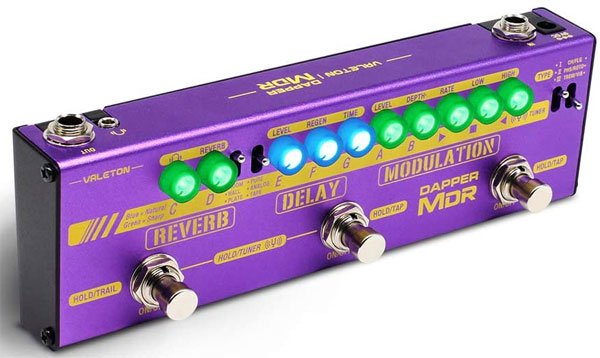
| Estimated Price | $130 |
| Type | Digital |
| Effects | Phase, Reverb, Modulation |
| Connectivity | 1 x 6.35mm Jack Input, 1 x Output |
| Power | 9 Volts DC |
My Review: The Valeton Multi-Effects Guitar Pedal is brimming with sonic-altering possibilities. Firstly, it has an interesting rectangular design that makes each of the three footswitches easily accessible. The brightly colored aesthetics make it easy to see all of the individual controls and know which effects you are selecting.
Let’s explore the various effects that this pedal has to offer. You get a total of nine modeling effects which can all be controlled using the tap tempo footswitch. These include phase, chorus, reverb, delay, vibrato, and tremolo. The phase-shifting effect can be tweaked from subtle to prominent.
Along with the high-quality phase, the delay and reverb settings are also worth mentioning. The analog tape delay takes you back to the days of tape machines in recording studios, and the reverb can be set to hall or plate. Each of the effects has individual parameters to control the characteristics and coloration of the output.
There’s also a tuner onboard the Valeton Multi-Effects pedal. It’s a 9-in-1 pedal that can do just about everything to a good standard. You can also use it on bass, keyboard, or vocals if you wish. It comes with a dedicated 9v power supply too.
Who This is Best Suited for: If you intend to fill up your pedalboard with various sonic-sculpting effects over the coming months, you can save yourself the hassle by acquiring the Valeton multi-effects pedal.
Bottom Line: The Multi-Effects pedal by Valeton has an impressive 9 modulation effects onboard. There are three high-quality delays and reverbs, a detailed phaser, and many more. All of these effects can be easily controlled using the tap tempo footswitch.
Popular Related Article: 17 Amazing Delay Pedals (Digital and Analog)
10. NUX MOD Core Deluxe
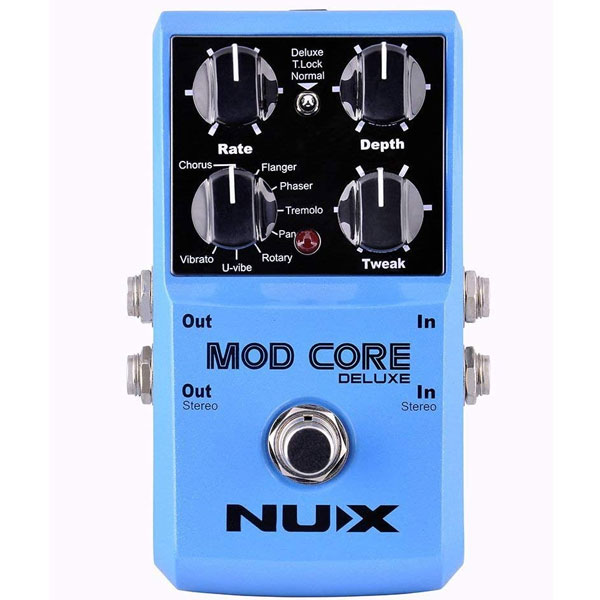
| Estimated Price | $80 |
| Type | Digital |
| Effects | Phaser, Chorus, Flange |
| Connectivity | 1 x 6.35mm Jack Input, 1 x Output |
| Power | 9 Volts DC |
My Review: NUX’s reputation as a provider of quality effects pedals continues to grow, and their MOD core Deluxe pedal is a good indicator of their progress. This affordable modulation pedal has eight different settings to choose from phaser, flanger, chorus, tremolo, rotary, pan, u-vibe, and vibrato.
When you have selected your chosen effect, you can use the four basic controls to adjust the Rate, Depth, Type, and Tweak. The Tweak control acts as a simple mix control, blending the pedal with your dry signal. Onboard the Mod Core pedal there is also a three-way toggle switch, which flicks between Normal, Deluxe, and Tone Lock modes.
Tone Lock essentially freezes the current settings of the pedal, disabling all of the other controls. You can also use this feature to store presets by pressing and holding the footswitch. The Mod Core also has true bypass switching and true stereo inputs and outputs. The pedal produces decent quality modulation but struggles to focus on one specific effect like phase.
Who This is Best Suited for: The NUX Mod Core multi-effects pedal gives you access to good quality phasers and other processing options. I’d recommend it to musicians who want plenty of options without having to break the band.
Bottom Line: As with many affordable multi-effects pedals, the NUX Mod Core struggles to focus on one particular effect. However, for the price, you do get access to a range of phasers, chorus, delays, and other options.
11. BOSS MD-200
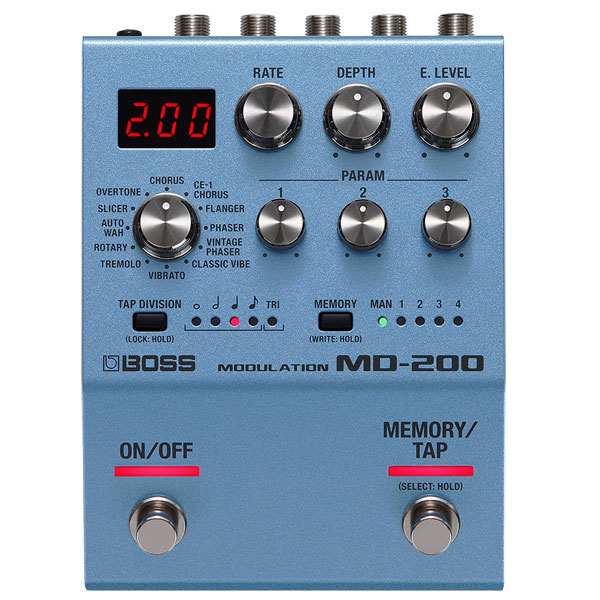
| Estimated Price | $250 |
| Type | Digital |
| Effects | Phase, Flange, Chorus, Auto Wah, Vibrato |
| Connectivity | 1 x 6.35mm Jack Input, 1 x Output |
| Power | 9 Volts DC |
My Review: With a total of 12 modulation modes based on the legendary MD-500 pedal, the BOSS MD-200 is filled with every modulation effect you can think of. This comprehensive pedal has a retro design and provides numerous options for externally controlling the unit. It can link up with footswitches, an expression pedal, and MIDI capabilities.
The insert function on the MD-200 can be used to integrate drive pedals for pre/post-processing. There is every modulation effect that you can think of included within this BOSS pedal. Each effect can be adjusted using the extensive tonal shaping options. The great thing about the MD-200 is that you can use it as a plug-in-and-play type of pedal, or spend hours tweaking the individual settings to create unique tones.
If you stumble upon a sound that you like and want to save, the MD-200 has a custom preset bank that stores all of your favorite tones. This is very useful as it removes the need to remember the settings that have created the sound, and allows you to access them instantly when the opportunity arises.
The D-200 has three controls along the top row Rate, Depth, and Effect Level. The Rate control affects the speed of your chosen effect – when used on the phaser it changes the pulsation of the rhythmic cycles produced. The Depth control adds coloration to the tone of the effect, and this is especially useful when using chorus or vibrato. Finally, the Effect Level control acts as a wet/dry adjuster, removing or adding some of the presence of the pedal in your overall output.
Who This is Best Suited for: I’d recommend the BOSS MD-200 to any musicians who have particular ideas of the tones they want to create with their effects pedals. The unrivaled detail of this pedal provides you with unlimited options when it comes to processing your guitar or bass.
Bottom Line: The BOSS MD-200 is a truly comprehensive effects pedal that produces every type of modulation in existence. The high-quality phaser comes with a variety of adjustable options, and you can save any setting to a preset slot with the push of just a few buttons.
12. Electro Harmonix Small Stone
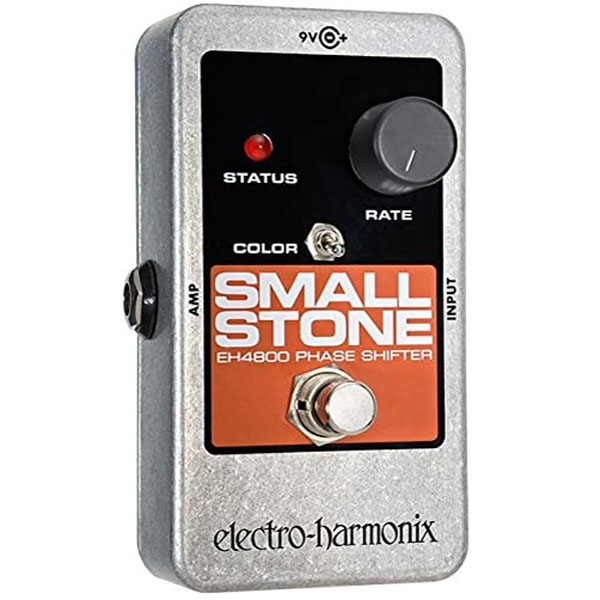
| Estimated Price | $100 |
| Type | Analog |
| Effects | Phase |
| Connectivity | 1 x 6.35mm Jack Input, 2 x Output |
| Power | 9 Volts DC |
My Review: The Nano Small Stone by effects pedal heavyweights Electro-Harmonix is a compact phaser that gives you access to a small number of refined tones. With three-dimensional phasing, the pedal’s output ranges from long, looping phase-shifting to short and rhythmic pulsations.
The onboard Rate control can be used to adjust the overall speed of the phasing sweep. By turning it clockwise, you get a faster rate and the effect becomes more noticeable. When the Color switch is flipped up, it creates a hollow tone by reducing some of the mid-range frequencies, therefore thinning out the overall sound. This is especially useful for breakdown sections or textural guitar parts.
Color control can also be used to affect the overall strength of the phaser effect. When it is in the non-color position and the sweep speed is set to a minimum, this diminishes the prominence of the effect. Between these controls, you can create a surprising amount of varying phaser tones. There’s also a true bypass footswitch that promotes maximum signal integrity.
Who This is Best Suited for: Electro-Harmonix pedals are renowned for the high-quality effects they produce, but sometimes they can seem overcrowded. The Nano Small Stone manages to combine simplicity with quality, so if you want an easy to use pedal that sounds great, look no further.
Bottom Line: The Electro-Harmonix Nano Small Stone is a minimalistic phaser pedal from a legendary effect pedal manufacturer. This pedal includes some interesting features such as the color switch, which allows you to add or remove certain frequencies. There’s also true bypass switching and speed/rate control.
13. Behringer VP1 Vintage Phaser
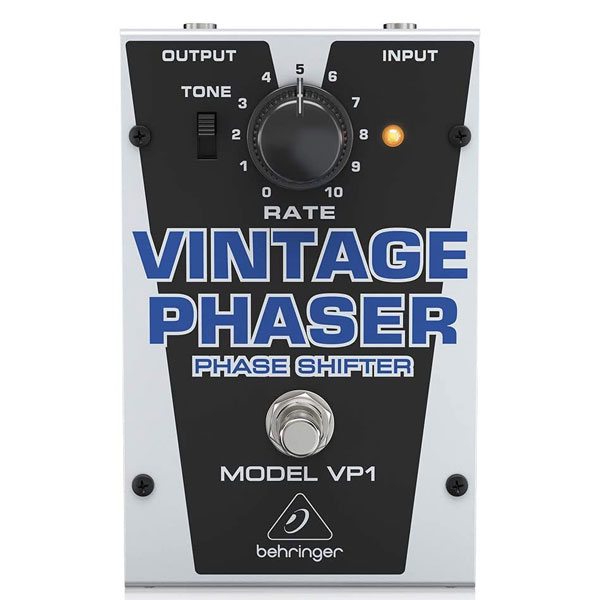
| Estimated Price | $60 |
| Type | Digital |
| Effects | Phaser |
| Connectivity | 1 x 6.35mm Jack Input, 2 x Output |
| Power | 9 Volts DC |
My Review: Behringer is known for its range of affordable entry-level effects pedals. The VP1 is their flagship phaser pedal, and in all honesty, it is of much better quality than most of their other offerings. It’s a single-minded pedal that does exactly what it needs to and does it well. The build quality is pretty robust, being made from an all-metal chassis. The design has a distinct vintage feel, with a black and white body and blue font.
The VP1 has two main voices that you can choose from. Firstly, there’s a classic phaser voice and a more dramatic modern styled mode. At its most dramatic, the pedal starts to sound more like a vibrato pedal than a phase-shifter.
The controls on the Behringer VP1 are very easy to operate. The Rate knob modifies the speed of the phaser, so you can create slow and defined sweeps or unleash the beast and create chaotic wobbles and swirls. The more you play around with the controls, the more you learn about the capabilities of this pedal. There’s also a Tone switch which alters the overall coloration of your output. There’s also a footswitch pedal with true bypass switching to protect your clean tone.
It’s always a good idea to limit your expectations where cheap pedals are concerned, by giving credit where credit’s due, Behringer has done a great job at delivering the performance you would expect from a top-end model. It has a warm undertone that thickens your sound, and the range of speeds that it produces makes it a very versatile option. As I previously mentioned, it’s even possible to create vibrato with this pedal if you mess around with the controls.
Who This is Best Suited for: If you want to find a happy medium between the top-end, expensive phaser pedals, and the more primitive entry-level ones, the Behringer VP1 Vintage Phaser pedal ticks the box. It is a great option for anyone who wants to further their knowledge of effects pedals and how phasers function.
Bottom Line: Behringer has done a great job with the VP1, producing an affordable phaser pedal that performs its limited number of functions very well. It’s fairly durable, easy to operate, and has a vintage warmth that will add character to your guitar.
Popular Related Articles: Guitar Pedals You Need To Check Out
14. TC Electronix Helix Phaser
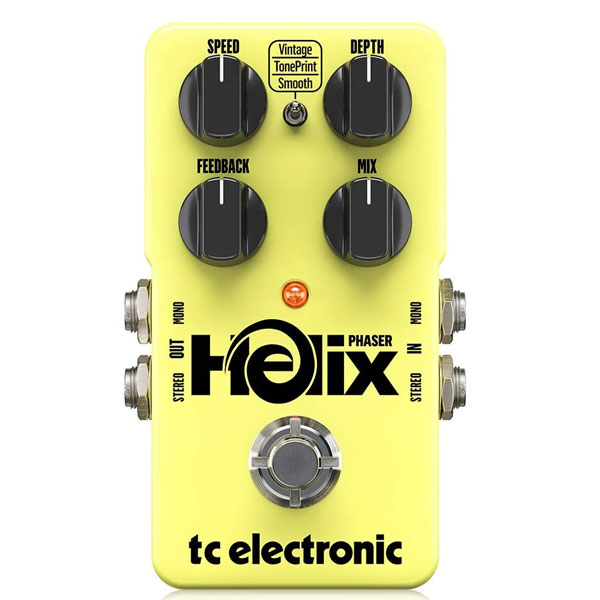
| Estimated Price | $130 |
| Type | Digital |
| Effects | Phaser |
| Connectivity | 1 x 6.35mm Jack Input, 1 x Output |
| Power | 9 Volts DC |
My Review: The Helix Phaser pedal by TC Electronic produces everything from gentle swirls in the style of David Gilmour, or aggressive Van Halen like sweeps. It’s filled with customizable modulation effects so that you can tailor the output to suit your needs.
The pedal comes with a dedicated DSP which powers the range of detailed phaser options. You can quickly switch between vintage shimmer modes or more modern-sounding tones in an instant. Another interesting feature is the TonePrint setting, which allows you to load up presets created by other musicians around the world.
The Helix Phaser pedal includes two effect models that are activated by the flick of a switch. You can use it as a subtle effect to add some color to your clean tone or go for more experimental tones by cranking up the various controls. The pedal can also be hooked up to a PC or MAC to fine-tune the presets and create tones that are individual to you.
The quality that makes the Helix stand out amongst other phaser pedals is its combination of digital flexibility and analog fidelity. Unlike most digital stompboxes, TC Electronic has married high-end analog circuitry with digital processing to create a pedal that has brilliant signal integrity.
Who This is Best Suited for: If you’d like to further your knowledge of modulation effects, the TC Electronic Helix Phaser can be hooked up to your computer where you can get into the fine details of the effects it produces.
Bottom Line: The TC Electronic Helix Phaser pedal combines analog warmth with digital performance. It produces a range of phaser tones that can be applied to any style of guitar playing. Whether you want to add a touch of modulation to your output or obliterate the dry signal with swirling waves, the Helix will suffice.
15. Keeley Dark Side
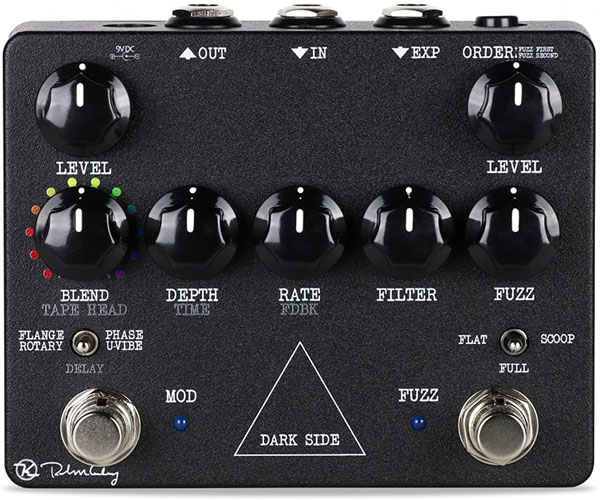
| Estimated Price | $300 |
| Type | Digital |
| Effects | Phase, Flange, Fuzz |
| Connectivity | 1 x 6.35mm Jack Input, 2 x Output |
| Power | 9 Volts DC |
My Review: The Dark Side by Keeley is a premium quality pedal that produces versatile phase-shifting along with many other effects. This comprehensive multi-effects pedal combines gritty fuzz, vintage tape-style delay, and many other modulation capacities.
Unlike with most multi-effects pedals where the detail is sacrificed in place of quantity, the Dark Side’s individual effects are good enough to take up a whole pedal on their own! It’s a great tool for creating psychedelic phaser tones, which can then be adjusted using the multiple onboard parameters.
The delay channel is especially detailed, offering 12 syncopated patterns all with authentic tape-sounds. The fuzz is based on the 1977 op-amp fuzz circuitry and cuts through the mix with ease. Then there’s the addition of an extensive modulation section.
The modulation options offered by the Keeley Dark Side will keep you occupied for a long time. There’s the versatile phaser, authentic sound flanger, rotary speaker, and u-vibe. The addition of an Order switch allows you to set the order of the effects on the pedal, so if you needed to use them in a certain sequence during a set, you can pre-empt this and prepare accordingly.
Who This is Best Suited for: The Keeley Dark Side Workstation pedal is akin to having a DAW on your pedalboard. It’s perfect for audio-nerds like me who love to adjust every aspect of the modulation effects. If you intend to invest in multiple high-quality pedals along with a phaser, this multi-effects offering will save you the hassle and space on your pedalboard.
Bottom Line: When it comes to detail, it’s difficult to think of a phaser pedal that can compete with the Keeley Dark Side. Not only does it provide you with an array of high-quality modulation effects, but you also get high-end fuzz and delays that are so good they could easily feature individually on separate pedals. I know the price tag might seem a little daunting, but it’s reflected in the quality of this pedal.
16. MXR EVH90
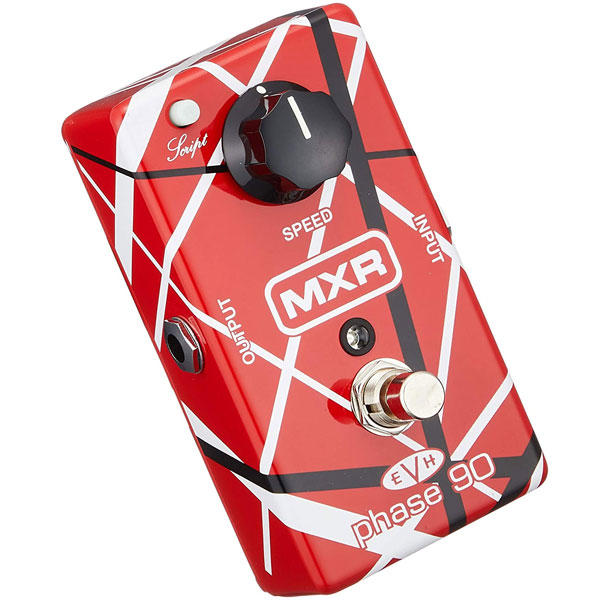
| Estimated Price | $230 |
| Type | Digital |
| Effects | Phase |
| Connectivity | 1 x 6.35mm Jack Input, 1 x Output |
| Power | 9 Volt DC |
My Review: MXR features on our list once again, with another variation of their classic Phase 90 pedal. This time, the EVH has been inspired by legendary guitarist Eddie Van Halen, who popularized phase-shifting throughout his career. Van Halen’s tone and pedal selection has long been sought after by guitarists, so having a pedal specifically styled on his sound is pretty cool if you ask me.
The EVH Phase 90 provides you with trance-inducing wobbles, and sonic whirlwinds that’s range from sharp and articulate to smooth and textural. Van Halen himself collaborated with the manufacturers to create the Phase 90, so you can be sure that his influence is accurate and authentic.
In terms of controls, you get a large rotary knob that affects the speed of the phaser. There’s also a newly added Script switch which allows you to toggle between an understated, vintage “Script Logo” phase tone, and a more aggressive, confrontational “Block Logo” phaser. The addition of a blue LED light provides a nice aesthetic touch, and the signature Van Helen red, white, and black stripes make this pedal stand out amongst its competitors.
Who This is Best Suited for: Simply put, if you’re a fan of the legendary Eddie Van Halen, you’ll adore the MXR EVH Phase 90 pedal. I’m sometimes skeptical when trying out signature pedals that claim to give you access to other musician’s tones, but because Van Halen played a big part in designing the original pedal, you can expect it to be both authentic and accurate.
Bottom Line: The MXR EVH Phase 90 is a unique phaser pedal that has a straightforward design. You can take Van Halen’s signature phase-shifted sound and customize it to suit your musical needs. The interesting design gives this pedal a feel of true individuality, and it sounds great when you push it to the limits.
17. JOYO R-09 Modulation Pedal
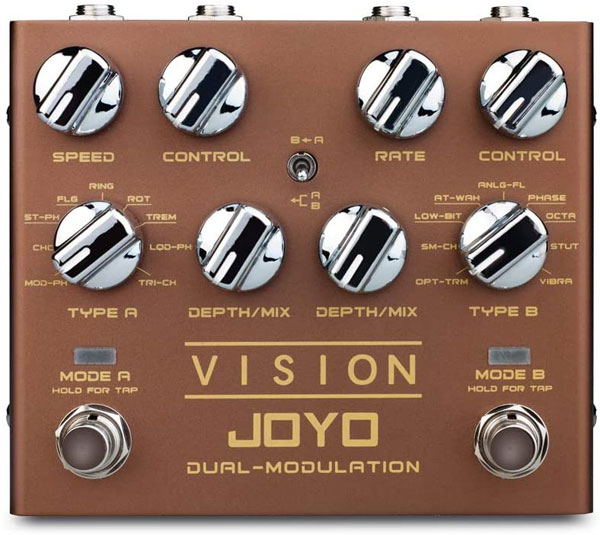
| Estimated Price | $90 |
| Type | Digital |
| Effects | Phaser, Chorus, Tremolo, Flange, |
| Connectivity | 2 x 6.35mm Jack Input, 2 x Output |
| Power | 9 Volts DC |
My Review: JOYO is quickly emerging as one of the most promising manufacturers of affordable effects pedals, and their detailed modulation pedal is another significant improvement. This dual-channel modulation pedal has an onboard phaser that is both versatile and authentic sounding. You can use the various controls positioned along the top row of the pedal to change the characteristics of the phaser’s sound.
This is more than your standard phaser pedal though. With a total of 9 effects per channel, you get 18 modulation effects that leave no sonic stone unturned. Along with the phaser, there’s vibrato that can be increased or decreased in speed using the dedicated rotary knob. Then you have auto-wah, which can be tempo-synced using the tap tempo footswitch. Next, you get a low-bit effect that transforms your guitar into an old-school ringtone. There’s also an octave shifter that goes up or down by 2 octaves, a warm sounding tremolo, and a looper.
It’s fair to say that for the price, you won’t find a pedal as detailed as the JOYO Modulation R-09. Not only do you get access to the large number of effects I just listed, but you also get a total of six adjustable controls that can further tweak your tone. The two channels have separate controls so that you can set up two effects simultaneously and toggle between them using the footswitches. You simply hold down the footswitch to activate Tap Temp mode, where you can sync the rhythm of the effects with the rest of your band or a backing track.
Who This is Best Suited for: Let me start by saying that the JOYO Modulation R-09 could be confusing to someone who is just starting on their journey with effects pedals. However, if you would like to expand your knowledge of audio manipulation and effects, it’s the perfect platform to learn about phasers and every other aspect of modulation.
Bottom Line: The JOYO R-09 is an incredibly detailed phaser and modulation pedal that can do just about anything you ask it to. There are the classic staple modulation effects like phase, chorus, and tremolo, but also some weird and wonderful offerings that will inspire you to keep experimenting. At around $90, it’s an absolute steal.
Choosing the Right Phaser Pedal (Buying Guide)
Phaser is a term that was first coined to describe a variety of tape flanging, which is the process of a pair of tape reels being played simultaneously but with one of them slowed down purposefully. This produces a swirling sound that has developed into what we now call a flanger.
Phaser pedals broke away from flangers in the late 1960s, with guitarists like Jimi Hendrix popularizing the effect. These pedals allowed guitarists to add psychedelic overtones to their sound, captivating audiences and producing out-of-this-world guitar tones.
How is Phase Produced?
The phase is the technical term for a certain position on a frequency spectrum. An audio waveform is essentially many phases starting and finishing as they reach the zero axes. The effect that is produced by a phaser pedal is more accurately described as a “phase-shift”.
The phase shift is produced when two of the same signals are mixed. One of the signals is dry and unprocessed, while the other is put through an all-pass filter which allows any of the frequencies to be boosted or cut. By using an LFO (low-frequency oscillator) to move the position of the all-pass filter, the result is a combination between the processed signal and the original.
The LFO’s ability to move the filter causes the sound to fluctuate in and out of phase. This results in the two signals lining up, then going out of alignment repeatedly. This constant movement between being matched up and unmatched causes the effect that we know as a phaser.
It’s possible to add more and more layers, or stages to a phaser pedal by using more than one all-pass filter. More feedback can be generated, run back through the pedal’s input, and adding another layer to the overall sound.
Digital distortion is caused by clipping of digital audio, and generally produces a harsher, extreme distortion than that of a tube amp. For example, overdrive distortion pedals work by applying an increase in gain at certain points in the audio output. Much like a compressor, these pedals usually have thresholds built in to determine which parts of the guitar input are quiet or loud and then adding distortion to the louder notes.
Unlike overdrive pedals, standard digital distortion pedals don’t rely on controlled clipping. Instead, these stompboxes adjust the shape of the audio wave to create certain patterns, whilst not being dependent on the amount of gain. This creates more of a flat response without the warmer overtones of a tube amplifier or an overdrive distortion pedal.
Phasers vs. Flangers vs. Chorus
Phasers, flangers, and chorus pedals are often put in the same category because they use similar processes to create the desired effect. It would be correct to say that phasers are a byproduct of the flange, but the two effects have some distinct differences when they are produced by guitar pedals.
As we’ve already established, phaser pedals split the signal of a guitar or bass into two identical copies. The phase of one of the copies is shifted, and then the two are mixed back together to create the effect. Certain frequencies are created, swept through the frequency band, and creating a swirling effect.
Flangers sound pretty similar to phase shifter pedals, but they have a more noticeable impact on your tone. As with a phaser, the signal is split into two identical copies, then one of the signals is slightly delayed by up to 20 milliseconds. The result is a sound that has more harmonic complexity than a phaser, with more saturation occurring.
Chorus pedals are also similar to phasers and flangers in the way they operate. They too clone the signal but use a longer delay time between them. This creates a less intense effect than the previously mentioned duo. Chorus is especially effective when used in stereo, as it creates space between two speakers.
Common Parameters and Controls Found on Phaser Pedals
Here’s a breakdown of the controls that are commonly featured on phaser pedals
- Level
- Rate/Speed
- Feedback
- Depth
Before deciding on a pedal, it’s always useful to familiarize yourself with the controls and what they do to your sound. Phaser pedals are quite simplistic when it comes to parameters, but each one plays an integral part in producing the effect, and changing them can dramatically transform the results.
The Level control is quite self-explanatory, but important nonetheless. It is sometimes labeled as Wet/Dry or Mix on a phaser pedal. This controls the amount of the effects that are applied to the signal in comparison to the amount of the dry signal. When the Level control is set low, the effect will be subtle and hard to notice. Conversely, when it is cranked up, the phaser effect becomes extremely prominent and in-your-face.
The Rate/Speed parameter controls the speed of the Low-Frequency Oscillator (LFO). This in turn affects the position of the all-pass filters that are fitted into the pedal. When the rate is set to low, the effect opens and closes slowly. When this control is set too high, the movement becomes more aggressive and your tone is transformed into a futuristic swirl.
The feedback control adjusts the amount of output that is run back through the pedal’s input. Similar to the unwanted feedback that occurs when a microphone is positioned near a speaker; it causes the signal to be joined by a variety of noisy tones. This is great for creating dramatic, mind-boggling sounds with your guitar.
Finally, the depth control is responsible for adjusting the overall size of each peak and trough that passes through the all-pass filter on the phaser pedal. Turning up the depth parameter will cause the peaks and troughs to become amplified, therefore warping the sound of your guitar dramatically.
Multi-Effect Phaser Pedals
Some of the phaser pedals I reviewed earlier in the article also have the capabilities to produce an array of other effects. These pedals are known as multi-effects pedals and can be a great option if you plan to add multiple effects to your pedalboard. It’s usually cheaper to purchase a multi-effects pedal than it would be to source all of the pedals individually.
The only downfall to multi-effect phaser pedals is that they usually lack the attention to detail of a singular-effect pedal. This is understandable as the manufacturer has to focus on producing a multi-purposed pedal and so doesn’t spend the same amount of time perfecting the phaser as they perhaps would on a single-purposed pedal.
Using Phasers on Drums
An interesting application for a phaser pedal is using it to process drums. It’s common in the genre of psychedelic rock to hear phase and flange that has been applied to an acoustic drum kit, creating unique overtones and adding a dreamy feel to the percussion.
The only potential issue is that if you use a phaser on the whole drum kit, it could become messy because of all the different frequencies that are produced by the snare, kick, toms and cymbals. A good way around this is to apply the phaser exclusively to one drum so that you can tweak it to match the frequency range of that particular part of the drum kit.
Applying a phaser to the cymbals is a great way to bring them to life. This can be done by isolating the overhead microphones and re-amping the recordings through your phaser pedal retrospectively.
Phaser Pedals in the Studio
When it comes to using phaser pedals in the recording studio, you essentially have two choices. You can either run your guitar or bass into the pedal, then into an amplifier, and use a microphone to record it. This technique offers consistency between your live sound and the recording, but it also means that the amplifier has a big impact on the coloration of your sound.
The alternative method is to run your guitar or bass into the phaser pedal, then straight into the direct input on your audio interface. This cuts out the need for an amp, and consequently, you lose the natural characteristics of the amplifier. However, the advantage of this method is that you are processing the clean signal of your instrument, and so there is more room to tweak the sound through processing within your DAW after you’ve recorded.
Of course, there’s always the option of using VST plugins to produce phasers. This method allows you to be more precise, but it can lack the human element provided by a phaser pedal. One technique is to blend VST plugin effects with pedals, to create a perfect middle ground. You can set up the controls on each of the phasers to work in sync, then blend the two.
Where Should a Phaser Pedal Be Positioned in Your Signal Chain?
Phaser pedals are classed as modulation effects, and generally speaking, they are positioned towards the back of your signal chain. Space-based effects like delays and reverbs are usually positioned after them, but other than that, phase comes before most other pedals.
That is only a suggestion though, and there are certainly other ways to layout your signal chain and get interesting results. The reason that phrase is traditionally placed after other effects is that this means that all of the other pedals will be affected by the phaser pedal, including distortion based pedals, EQs, filters, or compressors.
In my personal experience, I’ve stumbled across some of my favorite sounds when doing things the “wrong” way. Sometimes, having an idea of where pedals should be positioned can limit your sound-sculpting possibilities. It’s important to play around with the order of your effects pedals and see which combinations sound pleasing to your ear.
Dual Amplifier Setups and Phase Pedals
You might have noticed that some of the phaser pedals reviewed in this article have two outputs. The reason for this is that it gives a guitarist the option of splitting their signal and sending separate outputs to a pair of amplifiers.
If you’ve never heard of this concept before, it may seem a little confusing at first. In reality, it’s pretty simple though. You isolate your guitar or bass’ clean signal and send that to one amplifier, then isolate the wet signal that is affected by your pedals and send that into a separate amplifier.
As a result, your clean tone is always playing underneath the processed signal. This is especially useful for those who are in bands with only one guitarist, or for bassists who want to thicken up their sound. Because the clean signal continues to play all the time, it creates the illusion of having an extra guitar and adds more substance to the overall tone.
Combining Phase with Other Effects
Phaser pedals are compatible with many other effects. The phase is versatile and sounds great when used to subtly change the tone of a guitar or bass. Adding a touch of reverb or delay emphasizes the swirling nature of a phaser pedal, and softens the overall tone. The more you turn up the decay on a reverb pedal, the more ambient and spacey the phased signal becomes.
Alternatively, combining phaser pedals with more extreme effects like fuzz or distortion also creates an interesting concoction. The grittiness of a distortion-based pedal interacts with a phaser to produce pulsating, rhythm circles of sound. The more dirt you add to a phased signal, the more intense the tone becomes.
Many other effects can also be combined with phaser pedals, such as wah-wah, compression, looping, and octaves. The key is to play around with the settings to find mixtures that you like, and in the process gaining newfound knowledge on audio processing that you can take into the studio.
Phase and Bass
Although most of the phase pedals featured in this article are predominantly for electric guitars, there’s no reason that they won’t sound great with bass. I’ve found that using guitar pedals for bass sometimes produces interesting results. The pedal is likely to affect the treble end of a bass guitar, so you still get the thick low-end with some decoration on top.
Power:
The majority of the listed phaser pedals in the first section of this article run off 9 volts DC. In some rare cases, effects pedals require 12 volts. Some may come equipped with dedicated power supplies, or you can use your own.
In some cases, the phaser pedals are capable of being powered by 9-volt batteries. This is convenient if you are playing a show with limited power supplies, or you want the peace of mind of knowing that if your power supply cuts out, the batteries will keep the pedal-powered.
Conclusion:
There are fewer more satisfying sounds than a guitar with a swirling phase applied to it. This effect can be used in several ways, and its versatile nature lends itself to many genres.
All of the pedals listed in this article will enhance the sound of your instrument. It’s important to do your research and establish what you want from a phaser pedal before purchasing. Hopefully, after reading this guide you can make more of an informed decision and select the perfect phaser pedal to suit your needs.

My name is Chris and I’ve had a passion for music and guitars for as long as I can remember. I started this website with some of my friends who are musicians, music teachers, gear heads, and music enthusiasts so we could provide high-quality guitar and music-related content.
I’ve been playing guitar since I was 13 years old and am an avid collector. Amps, pedals, guitars, bass, drums, microphones, studio, and recording gear, I love it all.
I was born and raised in Western Pennsylvania. My background is in Electrical Engineering, earning a Bachelor’s degree from Youngstown State University. With my engineering experience, I’ve developed as a designer of guitar amplifiers and effects. A true passion of mine, I’ve designed, built, and repaired a wide range of guitar amps and electronics. Here at the Guitar Lobby, our aim is to share our passion for Music and gear with the rest of the music community.
